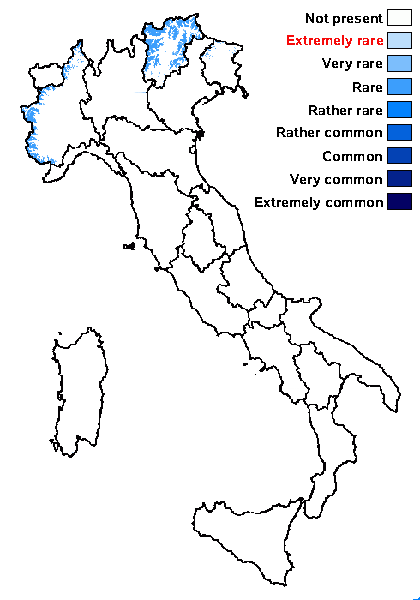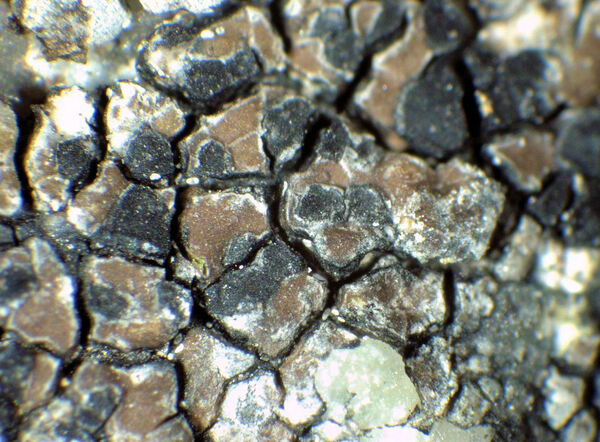Lecidea rapax Hertel
Herzogia, 1: 426, 1970.
Synonyms:
Distribution: N - Frl (Tretiach & Hafellner 2000), TAA (Hertel & Schuhwerk 2010, Nascimbene & al. 2022), Piem (TSB 34492).
Description: Thallus crustose, episubstratic, 0.5-2 mm thick, areolate, of flat to convex, up to 3 mm wide, yellow-brown, copper-brown or dark reddish brown areoles with a whitish to grey edge (without the production of thallospores), constantly growing on the thalli of Bellemerea alpina or B. cinereorufescens; prothallus absent or usually conspicuous, dark. Algal layer strongly discontinuous; medulla white, I+ intensely blue-violet, Apothecia lecideine, black, 0.5-11(-1.5) mm across, often clustered, constricted base, with a flat to convex, rarely bluish-pruinose disc, and a persistent, raised, often slightly wavy proper margin. Proper exciple of parallel-radiating, 3-7 µm thick hyphae, blue- to green-black in outer part, colourless or very pale brown within; epithecium olive-green; hymenium colourless to very pale greenish in upper part, 40-55 µm high, I+ blue; paraphyses conglutinated, usually simple, rarely anastomosing, 2-2.5 µm thick at mid-level, the apical cells clavate, to 4 µm wide; hypothecium brown, I+ blue. Ąsci 8-spored, clavate, Lecidea-type. Ascospores 1-celled, hyaline, ellipsoid-oblong, with rounded ends, 7-10 x 3.5-4.5 µm. Photobiont chlorococcoid. Spot tests medulla K+ yellow turning red (needle-like crystals), C-, KC-, P+ yellow. Chemistry: norstictic acid syndrome. Note: on siliceous rocks, growing on the thalli of Bellemerea-species; closely related to L. leprosolimbata, and so far known only from the Alps (Hertel 2006). Roux & coll. (2014) considers this species as a silicicolous ecotype of L. leprosolimbata.
Growth form: Crustose
Substrata: rocks
Photobiont: green algae other than Trentepohlia
Reproductive strategy: mainly sexual
paras Bellemerea
Commonnes-rarity: (info)
Alpine belt: rare
Subalpine belt: very rare
Oromediterranean belt: absent
Montane belt: absent
Submediterranean belt: absent
Padanian area: absent
Humid submediterranean belt: absent
Humid mediterranean belt: absent
Dry mediterranean belt: absent

Predictive model
Herbarium samples
Growth form: Crustose
Substrata: rocks
Photobiont: green algae other than Trentepohlia
Reproductive strategy: mainly sexual
paras Bellemerea
Commonnes-rarity: (info)
Alpine belt: rare
Subalpine belt: very rare
Oromediterranean belt: absent
Montane belt: absent
Submediterranean belt: absent
Padanian area: absent
Humid submediterranean belt: absent
Humid mediterranean belt: absent
Dry mediterranean belt: absent

Predictive model
| Herbarium samples |
 Index Fungorum
Index Fungorum
 GBIF
GBIF



